Long
Island Pavilion
-
Plan Pavilion to
Show
-
L.I.'s World at the
Fair
-
By GROVER RYDER
|
- .....An
ambitious plan for Long Island participation in the 1964 New
York World's Fair was outlined yesterday by the Long Island Association.
- .....Included
in the master plan is a Long Island Exhibits Pavilion of futuristic
design which would be built at the Flushing Meadow fairground
"to serve as a spectacular showcase for commerce, industry,
recreational and education facilities in the Long Island area."
-
-
Artist's sketch shows proposed Long Island exhibits
pavilion for World's Fair. It is topped by an observation deck
and a map motif of Long Island runs down its side.
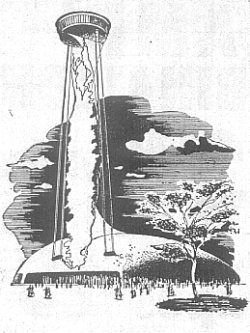 |
-
- SOURCE: New York Daily
News, August 22, 1960
|
- .....The
streamlined structure, designed to meet the requirements of all
Long Island participants, would be 150 by 488 feet. It would
enclose on two floors a total of 100,000 square feet of exhibit,
theatre and special events space.
-
-
Plan Monorail Lift
- .....The
pavilion would be dominated by an observation deck and restaurant,
accommodating several hundred people. It would be reached by
a monorail lift which would also provide a view of the fair.
- .....The
proposed plans also call for a rolling sidewalk that would move
the audience the length of the building, providing a view of
the exhibits and special features below.
- .....A
preliminary sketch of the pavilion and an outline of the LIA's
program for the fair have been approved by Stuart Constable,
vice president in charge of operations for the World's Fair Committee.
- .....The
LIA is presently one of the prime backers of the Long Island
Fair to be held this fall in Roosevelt Raceway.
-
-
Linked With L.I. Fair
- .....LIA
President Morris Rochman declared that it was significant that
all companies under-writing Long Island's preliminary planning
for the World's Fair also are closely identified with the improved
and expanded Long Island Fair.
- ....."This
relationship," he added, "is not accidental, but part
of the long range planning of the LIA. It included the intention
to construct our World's Fair facilities so that they may be
claimed at the close of the 1964-65 exposition and made part
of the continuing Long Island Fair."
|
Arnold
Bakeries
|
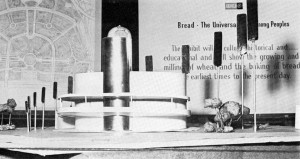
-
SOURCE: NY World's
Fair Progress Report No. 2,
-
May 8, 1961
|
Model of the proposed Arnold Bakeries
Pavilion. The baker was among the first firms to express an interest
in the Fair. |
Camp
Cayuga at the Fair
|
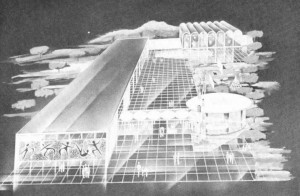
-
SOURCE: NY World's
Fair Progress Report No. 2,
-
May 8, 1961
|
Camp Cayuga at the Fair was planned
as a 40,000 sq. foot day camp for children. |
United
Nations Agencies Pavilion
|
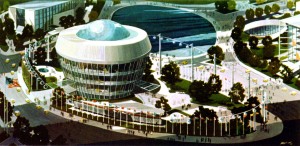
-
SOURCE: NY World's
Fair Progress Report No. 4,
-
January 17, 1962
|
The World's Fair Corporation worked
hard to get the United Nations to sign on with the Fair. The
pavilion would have occupied a site near the Vatican Pavilion
beside the Long Island Expressway. The UN choose to sponsor a
pavilion at Montreal's Expo67 instead. In 1965, the United Nations
did participate in the Fair and assumed occupancy of the vacated
Sierra Leone Pavilion. |
Pavilion
of Argentina
|

-
SOURCE: NY World's
Fair Groundbreaking Brochure for the Pavilion of Argentina,
September 11, 1963
|
The strange case of the Pavilion
of Argentina... This pavilion was actually constructed by a private
Argentine group to host the exhibit of Argentina. The pavilion
was completed but the sponsors of the pavilion could not secure
the financing to provide exhibits or staffing. So the pavilion
was completed without a tenant!
The World's Fair Corporation
assumed control of the structure. In 1964, the building housed
an exhibit of contemporary art. In 1965, the building housed
the Bargreen Buffet!
|
Senegal
Pavilion
|
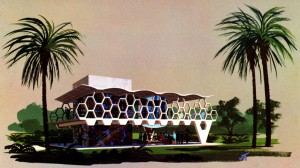
-
SOURCE: NY World's
Fair Progress Report No. 4,
-
January 17, 1962
|
Many emerging African nations wished
to participate in the Fair, Senegal among them. Senegal had selected
a site along the Avenue of African Nations in an area that eventually
hosted the Garden of Meditation. |
Heartland
States Exhibit
|
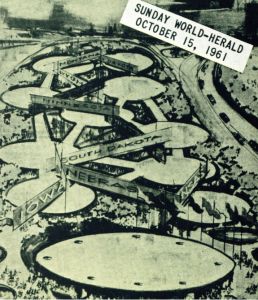
-
SOURCE: NY World's
Fair Progress Report No. 4,
-
January 17, 1962
|
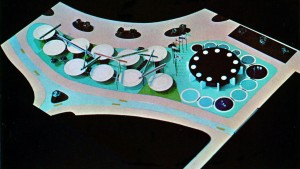
This 44,000 sq. foot pavilion
would have held the exhibits of the states of America's "heartland"
... North and South Dakota, Nebraska and Kansas. Neighboring
states had been invited to join in the pavilion. Commissioners
were appointed from each of the four states and the exhibit was
to feature a film with a new type of projection system. The site
of the pavilion, across from the Federal Pavilion and adjacent
to the New Mexico exhibit, remained vacant during the Fair.
|
Agriculture
Pavilion
|
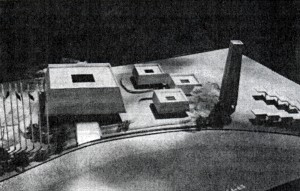
-
SOURCE: Unknown,
contribution of John Loughead
|
The Agriculture Pavilion would have
evoked traditional American farm structures in its form and use
of wood and shingles. The project consisted of a large, barn
like building housing the main displays, a tower reminiscent
of a silo, and smaller pavilions for livestock and produce displays
similar in feeling to a county fair. The pavilion would have
occupied a site on the Pool of Industry, between that of the
Equitable Demograph and the Hall of Education. The site remained
vacant during the Fair. |
Graphic
Arts Pavilion
|

-
SOURCE: NY World's
Fair Progress Report No. 5,
-
May 17, 1962
|
The proposed Graphic Arts Pavilion
would have been a multi-exhibitor pavilion located on a site
in the Industrial Area that eventually was occupied by the Pavilion
of American Interiors. Not much is known about this pavilion
and the potential exhibitors that they solicited. However, the
pavilion remained on the Fair's Site Map until at least April
of 1963 before it quietly disappeared. |
American
Art Pavilion
|
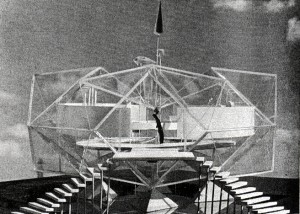
-
SOURCE: Unknown,
contribution of John Loughead
|
In a garden of flowers, pools
and fountains, an arrangement of four kite-like structures and
a central dome would have housed over 1,200 pieces of contemporary
art. An exhibition devoted to the history of art in America and
live demonstrations of the techniques of various media would
occupy the "theme building," the central dome.
The dome would have used an entirely
new structural system of prefabricated pieces of perforated aluminum
with transparent plastic fillers. Similar auxiliary structures
(shown at left) were used in an exhibition in Israel in 1962.
|
The
World of Food
|

-
SOURCE: NY World's
Fair Progress Report No. 5,
-
May 17, 1962
|
The fascinating story of The
World of Food has been explored in its own Feature at nywf64.com and you are invited to visit it.
Briefly, this multi-exhibitor
pavilion occupied a site directly across from the main entrance
to the Fair. Ground was broken and the steel skeleton was erected.
Financial difficulties for the organizers resulted in major delays
in construction. In April, 1964, just weeks before the opening
of the Fair, the Fair Corporation ordered the steel dismantled
and the site seeded over so that the eyesore would not greet
visitors at the Fair's main entrance. Exhibitors who had contracted
for space were offered exhibit space in the Better Living Building.
|
Pavilion
of Israel
|
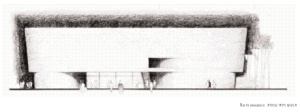

-
-
SOURCE: Presented
courtesy of The Genia Schreiber University Art Gallery, from
the exhibition catalogue "David Reznik: A Retrospective,"
Curator: Sophia Dekel Caspi, Gallery Curator: Prof. Mordechai
Omer
|
Israel had originally planned
to officially participate at the Fair. The Israeli Cabinet had
approved funding and architect David Reznik had won the national
architectural competition for the design of Israel's pavilion.
According to the Exhibition Catalogue,
"David Reznik: A Retrospective," "The
pavilion was designed as a truncated fortress, with only a few
narrow, horizontal openings; it was three levels high, the movement
between levels flowing on a sloping spiral ramp. The corners
were rounded to create an elegant silhouette, softening its heavy
appearance, and the surface was covered with rough plaster."
The pavilion would have occupied
the site that was eventually assumed by the African Pavilion.
Israel withdrew from the Fair for budget reasons and decided
to concentrate their efforts on an exhibit at Montreal's Expo67.
This designed served as the basis of their exhibit for that Fair.
|
Marine
Center Exhibit
|
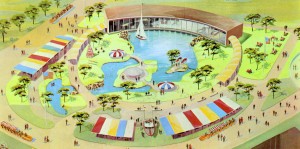
-
SOURCE: NY World's
Fair Progress Report No. 5,
-
May 17, 1962
|
The Marine Center signed on early
with the Fair and remained on the Site Map until 1963. It would
have occupied the 130,000 sq. foot site that was assumed by the
Hall of Science in the Transportation Area of the Fair. It included
a curved pavilion bordering on an artificial lake with below-water
lower level where visitors would see underwater exhibits through
a glass wall. The upper levels would display boats and related
marine products. |
Motoring
Safety Center
|
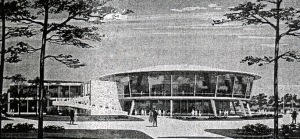
-
SOURCE: Unknown,
contribution of John Loughead
|
The Motoring Safety Center would
have featured driver-operated miniature cars speeding along a
miniature highway network over a miniature countryside. An observation
platform for Fair visitors would be constructed above. The exhibit
would have included a driver education theater and testing rooms
to determine driver aptitudes and skills. |
State
of Georgia
|
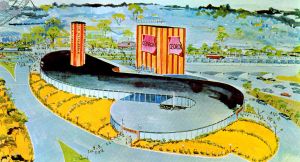
-
SOURCE: NY World's
Fair Progress Report No. 5,
-
May 17, 1962
|
By mid-1962, the State of Georgia
exhibit was being developed by the state's Department of Commerce.
Funds had been allocated and an architect selected. The pavilion
would have occupied the 69,584 sq. foot site that eventually
hosted the Hollywood Pavilion. |
Arch
of the Americas
|
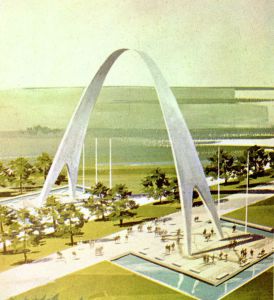
-
SOURCE: NY World's
Fair Progress Report No. 6,
-
September 12,
1962
|
The huge arch, sponsored by the
Organization of the American States (O.A.S. - North, Central
and South American nations, that is) would have spanned
the Avenue of the Americas near the Fair's main entrance.
The Fair Corporation was quite
excited about this feature of the Fair. It is shown prominently
in many of the Fair's official publications and it also appears
on many licensed souvenir products.
The O.A.S. withdrew their participation
and, along with them, went the Arch of the Americas.
Owens Corning was also interested
in constructing and hosting the arch, hoping for the same sort
of arrangement with the Fair Corporation that US Steel enjoyed
with their sponsorship of Unisphere. This association never came
to pass and the Arch went unconstructed.
|
Pavilion
of France
|
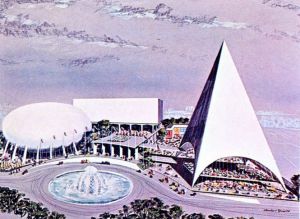
-
SOURCE: NY World's
Fair Progress Report No. 6,
-
September 12,
1962
|
The Pavilion of France would
have been one of the largest national pavilions at the Fair.
Consisting of three geometric forms, it would have occupied a
site behind the Pavilion of Spain, across from the Lunar Fountain.
Ground was broken for the pavilion
on February 5, 1963. This was a privately sponsored exhibit since
France could not officially participate in the Fair.
No doubt, having a French Pavilion
at the Fair was a matter of real pride to a World's Fair being
snubbed by the Paris-based Bureau of International Expositions.
However, construction of the pavilion never took place past the
groundbreaking. There eventually was a "French Pavilion"
at the Fair. It was closed by the Fair Corporation for not being
"French enough!"
|
American
Indian Exposition
-
SOURCE: Unknown,
contribution of John Loughead
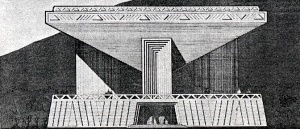 |
-
SOURCE: Fair
News,
-
December 20,
1962
 |
|
The American Indian Exposition
has been explored in its own Feature
at nywf64.com
and you are invited to visit it.
The American Indian Exposition
would have occupied a 33,000 sq. foot site in the Lake Area of
the Fair and would have been an integrated display of the history,
lore, crafts and tribal rites of the American Indians.
The ambitious original design
(top) would have featured a ground-floor exhibition area, a terrace
platform for outdoor exhibits and refreshments and a theater
supported on four immense piers that would have housed steps
and mechanical services.
The much scaled-back final design
(bottom) would have featured a Native American village. The exhibit
was never constructed.
|
World's
Fair Model Pavilion
|
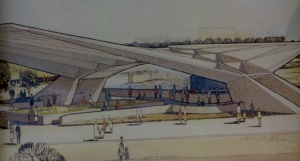
-
SOURCE: Unknown,
contribution of Gary Holmes
|
This Edward Durell Stone design
for a proposed pavilion at the 1964/1965 New York World's Fair
would have been constructed to house and display the Fair's Official
Scale Model. The World's Fair Corporation tried unsuccessfully
to find a sponsor for the pavilion. It was never constructed
and the American Express pavilion eventually played host to the
Fair's model. |
|
|